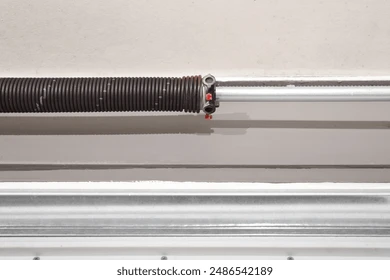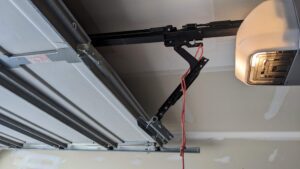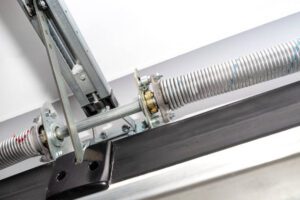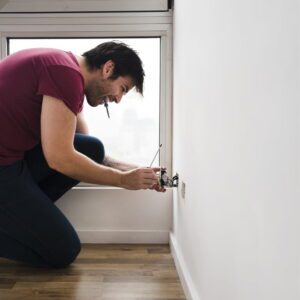Replacing a Broken Garage Door Spring: Do’s and Don’ts
Have you ever heard a loud snap in your garage and discovered it’s a broken garage door spring? Dealing with a faulty garage door spring is not only inconvenient but can also be quite dangerous due to the high tension they operate under—a mishap during a DIY repair could lead to serious injury. That’s why we often leave garage door spring repair to the professionals. Yet, it’s beneficial for us as homeowners to understand the basics of garage door springs, the role they play in the seamless operation of our garage doors, and the essentials of garage door spring replacement.
In this article, I’ll dive into the critical considerations for replacing a broken garage door spring. We’ll examine the signs that indicate spring failure, the distinctive types of garage door springs, and the safety measures to undertake when approaching a repair. With a lifespan of approximately 10,000 cycles, knowing the ins and outs of your garage doors’ springs replacement can be invaluable. Whether you’re pondering ‘garage door spring repair near me’, aiming to comprehend the procedure or considering the task of ‘garage door spring replacement’ yourself, this guide will offer a step-by-step approach for both torsion and extension springs, shedding light on common post-replacement issues. We’ll also touch on why it’s judicious to replace both springs when one fails, particularly when dealing with torsion springs. Let’s ensure your garage door replacement springs restore the harmony and safety of your garage door system.
Recognizing the Signs of a Faulty Garage Door Spring
Recognizing the signs of a faulty garage door spring is crucial for ensuring the safety and functionality of your garage door system. Here are key indicators to watch for:
- Difficulty in Operation: If opening or closing your garage door manually or with an automatic opener requires more effort than usual, it might be a sign of a faulty garage door spring.
- Visible Gap: A clear indication of a broken torsion spring is a visible gap. If you spot this, it’s time for a garage door spring repair.
- Partial Opening: Should your garage door only open about six inches, it’s likely that the torsion spring has failed, or the safety system has been activated.
- Weight Discrepancy: A garage door that feels heavier than normal suggests that the extension springs, which assist with the door’s weight, may be compromised.
- Loud Noises: A loud bang from the garage often signals a broken torsion spring.
- Abnormal Movement: Jerky motions or a door that closes too quickly are common symptoms of a broken spring.
- Cable Issues: Slacking or loose cables might indicate torsion spring problems, while broken cables can pose significant safety risks.
To avoid these issues, it’s important to conduct regular inspections:
- Visual Checks: Examine the springs, mounting hardware, pulleys, cables, and rollers for signs of wear or damage.
- Manual Door Lift Test: Lift the door manually to gauge spring functionality.
- Opener Force Setting Test: Verify that the automatic opener’s safety mechanism is operational.
At any sign of trouble, such as wear, separation, or loss of tension in the springs, it’s imperative to schedule a professional garage door inspection immediately. Remember, attempting DIY repairs on garage door springs can be extremely dangerous due to the high tension they operate under. Regular maintenance, including lubrication, can extend the life of your garage door springs and prevent the need for premature garage door springs replacement.
Understanding the Types of Garage Door Springs
Torsion Springs:
- Historical Use: Originating in the medieval period, torsion springs are mounted above the garage door. Their purpose is to provide uniform force for smoother operation, which in turn reduces stress on the garage door opener. This can lead to fewer repair costs over time.
- Mechanics: They work in conjunction with bearing plates and cable drums, which assist in the balancing act of lifting and lowering the garage door efficiently.
- Safety and Durability: Torsion springs are generally considered safer than their counterparts, as they offer uniform motion and are not visible, reducing the risk of accidental injuries. They also create less stress on the garage door opener, contributing to a longer lifespan of the entire system.
Extension Springs:
- Design and Function: An older technology, extension springs are installed on either side of the garage door. They operate using a 2-spring system that extends when the door is in use.
- Energy Dynamics: The tightly wound wire coil of extension springs stores energy when the door is closed. As the door opens, the energy is released, assisting in the lifting process, and then it’s dissipated when the door closes.
- Maintenance Considerations: Despite their widespread use, extension springs can be more costly to maintain due to their more fragile end connections that often fail prematurely.
Conversion Recommendations:
- For those seeking future savings and enhanced performance, converting from an extension to a torsion spring system is often recommended. Not only does this upgrade offer better efficiency, but it also contributes to overall safety and reduced maintenance costs.
Maintenance Tips:
- Lubrication: To prolong the life of garage door springs, they should be lubricated at least once a year. This simple step can prevent rust and ensure smooth operation.
- Inspection: Regular inspections are crucial to detect wear and tear. Identifying issues early can prevent unexpected failures and potential safety hazards.
In terms of garage door spring replacement, understanding the differences between torsion and extension springs is essential. Homeowners should consider not only the initial installation costs but also long-term maintenance and safety. Regular upkeep, including lubrication and inspection, will help keep your garage door springs replacement costs down and ensure the longevity of your garage door system. If you notice signs of wear or if your system is aging, it may be time to consult a professional for garage door spring repair or to discuss the benefits of converting to a torsion spring system for better performance and cost savings.
Safety First: Preparing for Spring Repair
Before we delve into the hands-on process of replacing your garage door spring, it’s imperative to prioritize safety to prevent any accidents or injuries. Here’s how to prepare for a garage door spring repair:
- Power Disconnection:
-
- Always start by disconnecting the power to your garage door opener to ensure it doesn’t activate unexpectedly. It’s wise to unplug the opener as an added precaution.
- Door Securing:
-
- With the power off, close the garage door and clamp it down. This will keep it from opening and causing potential harm or disruption during the repair.
- Personal Protection:
-
- Suit up in safety gear including goggles, sturdy gloves, and closed-toe shoes. This attire will protect you from any unforeseen mishaps.
- Tool Readiness:
-
- Gather all the necessary tools and keep them within reach. Ensure you have a safe workspace, keeping your head and limbs away from any moving parts. Remember, using the right tools is not just about efficiency; it’s a safety requirement.
- Torsion Tube Security:
-
- If you’re working with torsion springs, secure the torsion tube with vice grips before you begin winding or unwinding the springs.
- Professional Inspections:
-
- It’s recommended to schedule regular professional inspections to ensure all parts, especially springs, are in top condition.
- DIY Visual Checks:
-
- Between professional visits, perform your own visual checks for signs of wear like rust or fraying on the springs.
- Professional Balancing:
-
- Have a technician balance your garage door periodically. This helps distribute weight evenly and reduces strain on the springs and opener.
- Safety Cable Integrity:
-
- For extension springs, verify that safety cables are installed correctly and are intact to prevent springs from becoming dangerous projectiles if a break occurs.
- Lifespan Awareness:
-
- Be aware of the lifespan of your garage door springs and replace them when necessary due to wear or age.
- Emergency Preparedness:
-
- Know how to use the manual release handle on your garage door opener in case of an emergency.
- Under-Door Work:
-
- If you must work under the door, secure it with clamps or locking pliers to prevent it from falling.
Lastly, while it might be tempting to handle spring repairs on your own, the risks involved make it advisable to hire a trained garage door technician. They have the experience and tools to safely and effectively perform the job. Remember, incorporating these safety measures is not just about protecting yourself, but also about ensuring the longevity and proper functioning of your garage door system.
Step-by-Step Guide to Replacing Torsion Springs
When embarking on a garage door spring replacement, it’s essential to have precise measurements and an understanding of the process to ensure a safe and successful repair. Here’s a detailed step-by-step guide to replacing torsion springs:
Measuring and Identifying the Correct Torsion Spring:
- Inner Diameter and Wind Direction:
-
- Use a tape measure to determine the inner diameter (ID) of the broken torsion spring. This measurement is crucial for purchasing the correct replacement.
- Observe the direction in which the spring coils. The wind direction is either left-hand or right-hand, and it’s vital to select the corresponding replacement spring.
- Wire Size:
-
- To identify the wire size, measure a group of 20 coils and use this length to determine the correct wire size for your garage door spring replacement.
- Spring Length:
-
- Measure the length of the unwound spring, including any broken pieces. Combine these lengths and round up to the nearest whole number to find the total length needed to order the new spring.
Removing the Old Torsion Spring:
- Release Tension:
-
- Before removal, ensure that all tension is released from the existing springs to prevent injury.
- Unhooking Components:
-
- Using two 9/16″ wrenches, remove the old springs from the anchor bracket.
- Carefully remove the torsion spring drums and unhook the torsion cables.
- Spring Removal:
-
- Slide the old spring off the torsion bar, being cautious of residual tension.
Installing the New Torsion Spring:
- Spring Placement:
-
- Slide the new springs onto the torsion bar, making sure they’re positioned correctly according to the wind direction.
- Reattach Drums and Cables:
-
- Reattach the torsion spring drums and cables to the new springs, ensuring they are secure and properly aligned.
- Spring Attachment:
-
- Fasten the new springs to the anchor bracket, confirming they are tightly secured.
Winding the New Torsion Spring:
- Correct Number of Turns:
-
- Wind the new springs with the precise number of 1/4 turns appropriate for your door height. This is a critical step as improper tension can lead to garage door malfunction.
- Set Screws:
-
- Once the springs are wound, tighten the set screws to lock the springs in place. This step is vital to maintain the tension and proper operation of the garage door.
By following these steps and ensuring all measurements and procedures are executed with precision, you can complete a garage door spring replacement safely. However, due to the high tension involved in garage door springs, it is often recommended to seek professional assistance for garage door spring repair to avoid potential hazards.
Step-by-Step Guide to Replacing Extension Springs
When it comes to garage door spring replacement, particularly extension springs, it’s crucial to proceed with caution due to their high tension. Here’s a step-by-step guide to ensure you replace your garage door springs safely and correctly:
- Secure the Garage Door:
-
- Open the garage door fully to reduce tension on the springs.
- Place a sturdy step ladder under the door to keep it open and ensure it cannot close unexpectedly.
- Unplug the garage door opener to prevent any accidental activation during the process.
- Remove Old Springs:
-
- Carefully disconnect the safety cable from the old spring.
- If the extension spring cable shows signs of wear or damage, replace it with a new one before proceeding.
- Unhook the spring from the track bracket and from the eye bolt on the pulley or door frame.
- Install New Springs:
-
- Attach the new angle iron securely to the track and wall or ceiling to provide a stable anchor point for the new springs.
- Hook one end of the new spring onto the eye bolt and the other end onto the track bracket.
- When choosing a new spring, use the color-coded last coil for quick identification of the correct replacement spring. This will ensure you have the right spring for your door’s weight and size.
- Reattach Safety Cable:
-
- Thread the safety cable through the new spring, the guide pulley, and anchor it to the vertical bracket as it was previously installed. Taking a picture before removing the old setup can be helpful for reference.
- Consider taping the pulley wheel to the steel cable to prevent it from slipping and to ease the installation process.
- Test and Adjust:
-
- Measure the length of each extension spring to confirm they are equal. This ensures balanced lifting power on both sides of the door.
- Inspect all steel cables to make sure they are in good condition and have the correct tension.
- Reconnect the power to the garage door opener and test the door manually and with the opener to ensure smooth operation.
- Safety Inspection:
-
- Ensure the garage is clear of obstructions and that all tools are removed from the work area.
- Check that the springs are properly installed and that the safety cables are intact and securely in place.
By following these steps, you can complete your garage door spring replacement with confidence. If you’re replacing rusty springs on a one-piece 8×7 garage door, consider installing pairs on each side for even weight distribution, which can be sourced from North Shore Commercial Door. Remember, if at any point you are unsure or uncomfortable with the process, it’s best to consult a professional for garage door spring repair.
Troubleshooting Common Issues After Replacement
After performing a garage door spring replacement, you may encounter several issues that can affect the functionality of your garage door. Here are some troubleshooting tips to help you address common problems:
- Incorrect Spring Tension:
-
- If your garage door doesn’t open or close smoothly, the spring tension might be off. This can be adjusted by either adding or removing coils from the spring.
- For manual doors, increased friction could be due to wear on rollers or tracks. Regularly lubricating these parts should alleviate the issue and allow for smoother operation. (Advanced Garage Overhead Door Repairs).
- Persistent Noise:
-
- New springs may be noisy as they settle in. However, if the noise continues, it could point to issues with the track, rollers, or opener. It’s essential to inspect these components and ensure they are in good working order.
- Door Balance Test:
-
- Disconnect the opener and manually move the door to check its balance. The door should stay in place when left halfway open. If it doesn’t, you may need to make adjustments for even movement. (Four Common Garage Door Spring Problems).
- Cable Snap:
-
- If a cable snaps post-replacement, this is a serious concern and typically requires professional intervention due to the high tension and risk involved.
- Spring Measurement and Adjustment:
-
- Should the door not fully open or close with the motor, measure the springs and compare them to the door’s specifications. Confirm that the springs are properly adjusted and balanced. (How do you repair a garage door spring without replacing it?)
- Motor Struggles:
-
- If the motor still struggles after spring replacement, consider repair or replacement of the motor itself.
- Lifecycle of Garage Door Parts:
-
-
- Remember, the typical lifecycle for garage door parts is around three years. It’s important to keep this in mind when replacing springs and to consider replacing other components that may be nearing the end of their lifespan. (Replacing Multiple Parts After Broken Spring)
-
- High Usage Considerations:
-
- For garage doors that are used frequently, it’s worth investing in high cycle springs, nylon ball bearing rollers, new center bearings, end bearing plates, and cables to ensure durability and smooth operation.
By addressing these common post-replacement issues promptly, you can maintain the safety and efficiency of your garage door system. Remember to incorporate regular maintenance checks and consider the lifespan of all parts to avoid unexpected malfunctions.
Conclusion
As we’ve explored, the proper handling and replacement of garage door springs are essential for maintaining the functionality and safety of your garage system. Whether facing the robust torsion springs or the widespread extension springs, understanding their distinct characteristics and lifespan is key to preventing sudden failures. By recognizing the telltale signs of wear and damage, homeowners can ensure timely repairs, contributing to the longevity of their garage doors and enhancing home safety.
In conclusion, while the prospect of DIY spring replacement may seem cost-effective, the complexities and risks involved underscore the significance of professional assistance. The nuanced steps of measuring, winding, and adjusting springs, combined with the essential safety precautions, can often be best handled by experienced technicians. Regular maintenance, alongside informed decision-making when issues arise, will serve to uphold the seamless operation of your garage door and offer peace of mind.
FAQs
Q: Is it possible for me to replace the garage door spring on my own?
A: Replacing your garage door spring by yourself can be an option if you’re comfortable with DIY projects, aware of the safety risks, and have the necessary tools. However, it can be very dangerous and is not generally recommended.
Q: What steps should I take if my garage door spring breaks?
A: If your garage door spring breaks, you should use your garage door opener remote and carefully lift the door manually, taking the place of the spring. It’s important to proceed with caution and ensure your safety throughout the process.
Q: Can I operate my garage door if the spring is broken?
A: It is not advisable to operate your garage door with a broken spring due to safety concerns. If you must open it, for example, to retrieve a car, take precautions to protect yourself from injury.
Q: If one garage door spring breaks, should I replace both?
A: Yes, it’s recommended to replace both garage door springs even if only one has broken to ensure balanced operation and to avoid future issues.
Q: How safe is it to replace garage door springs?
A: Replacing garage door springs can be extremely dangerous due to the high tension they are under. It’s highly risky for homeowners to attempt this task without professional help.
Q: Is it possible to manually open my garage door with a broken spring?
A: Due to the significant danger posed by the tension in garage door springs, it is not recommended to manually open your garage door if the spring is broken.
Q: What is the risk of the garage door falling if the torsion spring breaks?
A: If the torsion spring breaks, the garage door can come crashing down since the counterweight against gravity is lost, posing a significant safety hazard.
Q: How long does it typically take to repair a broken garage door spring?
A: Repairing a broken garage door spring generally takes between 30 minutes to an hour. Professional assistance is crucial due to the dangers involved.
Q: Can I manually lift a garage door with a broken spring?
A: Manually lifting a garage door with a broken spring is not recommended because of the high tension in the springs, which can lead to serious injury or even death.
Q: What are the risks of replacing garage door springs without professional help?
A: Without the proper equipment and training, replacing garage door springs can lead to accidents, including broken fingers, lacerations, and head injuries.
Q: Is it possible to replace just one torsion spring on a garage door?
A: Yes, a torsion spring system can function with one new spring and one old spring. A professional installer can adjust the door to ensure it is balanced and operates smoothly.
Q: Can a garage door function with only one spring?
A: While it’s possible to use only one spring on a two-car garage door to cut costs, it compromises safety. On single one-car garage doors, one spring is usually sufficient to balance the door.






